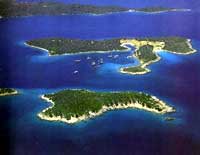SEHIR ISLAND
 Seven
nautical miles SW of Gokova Pier, at a spot near Çamli Limani are three islands
known as Sehir Adalari. The larger of these, which are situated between Çapa
Burnu and Domuz Burnu, is Saray Adasi or Cleopatra Island, as it is called by
the locals. It is also shown on nautical charts as Sehir Adasi or Sedir Adasi.
The other two islets are called Orta (Yuan) and Kucuk (Kale).
Seven
nautical miles SW of Gokova Pier, at a spot near Çamli Limani are three islands
known as Sehir Adalari. The larger of these, which are situated between Çapa
Burnu and Domuz Burnu, is Saray Adasi or Cleopatra Island, as it is called by
the locals. It is also shown on nautical charts as Sehir Adasi or Sedir Adasi.
The other two islets are called Orta (Yuan) and Kucuk (Kale).
There are remnants from the ancient city of Cedrai on the big island. It is
said that the Egyptian Queen Cleopatra basked on the beach and to feel more at
home, she had Marc Antony bring sand all the way from Egypt. While it is true
that the sand here has an unusual consistency, it was not shipped in all the way
from Egypt as the popular legend goes, but rather of a peculiar calcium
carbonate formation not found anywhere else in the region.
As you approach from the SW side, you will see a clean passage between Saray
Adasi and the mainland. You need to navigate clear away of the shallows in front
of the SE point of the island. Here, you can drop anchor in 5-7 m. of water over
hard-packed sand. It isnt very suitable to moor here overnight because the
tides get fairly high. For this reason, we recommend that you moor at Karacasögüt,
which is located 3.5 nautical miles to the SW. In addition, because the shoals
situated 400 m. W of Küçük Ada are so hard to make out in heavy seas, this
area is extremely dangerous for yachts. Those wishing to navigate between Saray
Adasi and Orta Ada must pass through the middle of the channel.
If you are approaching from the SE, it is possible to navigate between the
mainland and a small island called Mezar Adasi. You need to maintain a fair
distance away from the Ordek Kayaliklari which are 330 m. W of Saray Adasi. Also,
you will need to exercise extreme caution as you pass the sandbank situated 600
m. N of Orta Ada. There is a lighthouse on this island.
Besides the gleaming white sandy beach nice sand, there are two nice bays,
one of which is found on Saray Adasi while the other is in the E quadrant of
Orta Ada.
As we mentioned above, ruins of the ancient city of Cedreai are found in the
E quadrant of Saray Adasi, which resembles a valley that has been split in two.
Its ancient name is Cedreai, which means cedar, whereas the name Sedir Adasi (Cedar
Island) is also commonly used today. The island is surrounded by a fortification
wall which was constructed with ashlar blocks. In the middle of the island,
remains of an Apollo temple erected in the Dorian order can be seen on top its
platform. One can discern that the temple was transformed into a church during
the Byzantine Period. On the N slope of the island is an amphitheater in a
remarkably preserved state.
The theater with its 15 rows of seating was divided into nine sections with
wedge-shaped stairways. You will be amazed to see a theater here, the orchestra
part of which is buried. We found it rather astonishing that a theater of any
sort was erected on such a tiny island. It might have been used by the
inhabitants on the mainland and the other islands in the vicinity and perhaps
this island was inhabited as well. As it is, ruins of a necropolis are found on
the nearby mainland as well as those observed on the island confirm this point.
One can make out some ruins of ancient dwellings to the E of the theater.
The islands agora extends out towards the W. It is possible to see the
beautiful stonework of the agora walls, a section of which is still standing.
Here, inscriptions that been found of the variety that would generally be
uncovered in an agora. One of them mentions the rules and regulations of the
Three Athletes Holiday. At the same time, this inscription tells us of the
existence of a stadium that was here.
Besides the abundance of ruins on this inhabited island, it is possible to
see numerous knights coat of arms. This shows use that the island was used by
the Knights of Rhodes.
 Seven
nautical miles SW of Gokova Pier, at a spot near Çamli Limani are three islands
known as Sehir Adalari. The larger of these, which are situated between Çapa
Burnu and Domuz Burnu, is Saray Adasi or Cleopatra Island, as it is called by
the locals. It is also shown on nautical charts as Sehir Adasi or Sedir Adasi.
The other two islets are called Orta (Yuan) and Kucuk (Kale).
Seven
nautical miles SW of Gokova Pier, at a spot near Çamli Limani are three islands
known as Sehir Adalari. The larger of these, which are situated between Çapa
Burnu and Domuz Burnu, is Saray Adasi or Cleopatra Island, as it is called by
the locals. It is also shown on nautical charts as Sehir Adasi or Sedir Adasi.
The other two islets are called Orta (Yuan) and Kucuk (Kale).